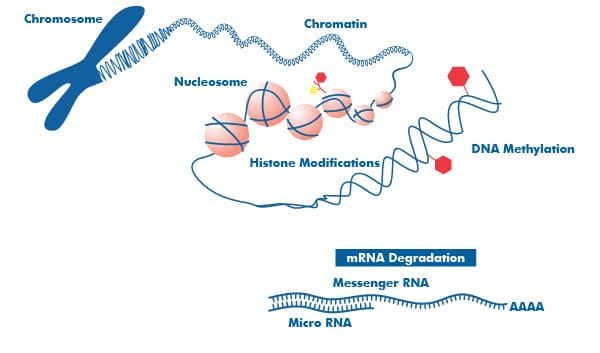
Epigenetics refers to the study of heritable changes in gene expression that do not involve alterations to the underlying DNA sequence. These changes can be influenced by various factors, including environmental signals, lifestyle choices, and developmental stages. The primary mechanisms of epigenetic regulation include DNA methylation, histone modification, and chromatin remodeling.
Mechanisms of DNA Methylation
DNA methylation involves the addition of a methyl group (CH₃) to the cytosine base of DNA, typically at CpG dinucleotides. This process is catalyzed by enzymes known as DNA methyltransferases (DNMTs).
- Methylation Process:
- DNMT1 is responsible for maintaining methylation patterns during DNA replication.
- DNMT3A and DNMT3B are involved in de novo methylation, establishing new methylation marks on previously unmethylated DNA.
- Methyl CpG Recognition:
- Methylated CpG sites are recognized by specific proteins known as “methyl-CpG binding domain” (MBD) proteins. These proteins recruit additional factors that can repress transcription.
- Demethylation:
- Active demethylation can occur through enzymatic processes involving ten-eleven translocation (TET) enzymes, which oxidize 5-methylcytosine to 5-hydroxymethylcytosine and further derivatives that can be replaced with unmodified cytosines.
Mechanisms of Histone Modification
Histones are proteins around which DNA is wrapped to form nucleosomes, the fundamental units of chromatin. Various post-translational modifications occur on histones, influencing chromatin structure and gene expression.
- Types of Modifications:
- Acetylation: Typically associated with gene activation; acetyl groups are added by histone acetyltransferases (HATs) and removed by histone deacetylases (HDACs).
- Methylation: Can be associated with either activation or repression depending on the specific amino acid residue modified (e.g., H3K4me3 for activation vs. H3K27me3 for repression).
- Phosphorylation: Often involved in signaling pathways and can influence chromatin dynamics during processes like cell division.
- Chromatin Reader Proteins:
- Chromatin readers recognize specific histone modifications and mediate downstream effects on transcriptional regulation. Examples include bromodomain-containing proteins that recognize acetylated lysines.
Chromatin Remodeling through CRFs
Chromatin remodeling factors (CRFs) facilitate the repositioning or restructuring of nucleosomes to allow access to transcription machinery:
- Mechanisms:
- ATP-dependent remodeling complexes such as SWI/SNF utilize energy from ATP hydrolysis to alter nucleosome positioning.
- These changes can expose regulatory regions of genes or compact them into inactive states.
Polycomb Silencing Mechanisms
Polycomb group proteins play a crucial role in maintaining gene silencing through two main complexes: PRC1 and PRC2.
- PRC2 Complex:
- PRC2 catalyzes trimethylation of H3K27 (H3K27me3), marking genes for repression.
- PRC1 Complex:
- PRC1 recognizes H3K27me3 and mediates further compaction or repression through ubiquitination of histone H2A.
Epigenetic Regulation in Cancers
Epigenetic alterations are frequently observed in cancer cells, contributing to tumorigenesis:
- Histone Onco-modification:
- Specific histone modifications have been linked to oncogenic processes; for example, aberrant H3K27me3 levels may lead to silencing tumor suppressor genes.
- Epigenetic Drugs for Cancer Treatment:
- Several drugs targeting epigenetic modifiers are under investigation or in clinical use, such as HDAC inhibitors (e.g., vorinostat) and DNMT inhibitors (e.g., azacitidine). These agents aim to reverse abnormal epigenetic states in cancer cells.
In summary, epigenetics encompasses a complex interplay between various molecular mechanisms that regulate gene expression without altering the genetic code itself. Understanding these mechanisms provides insight into developmental biology and disease states such as cancer.







